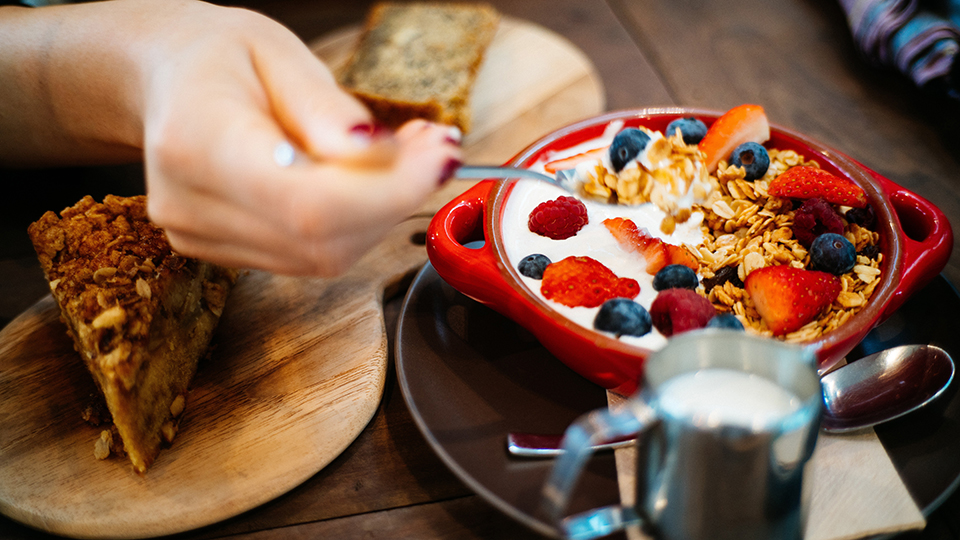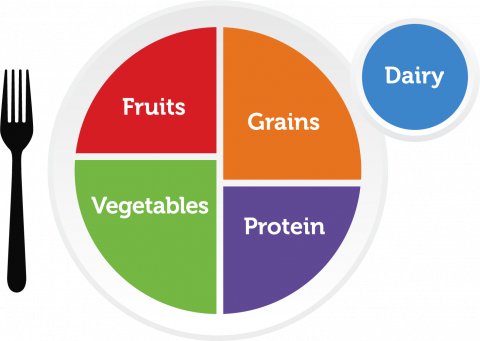Friday, October 20, 2023 Bits and Bites: Serve yourself – by building a healthy plate

Written by Jacob Sautter, dietic intern with Dining Services.
Serve Yourself is a program through Dining Services to teach you how to use food to your advantage. Nutrition is a tool to help you achieve a variety of goals. For example, you can utilize food to give you the energy to carry you through long study sessions, achieve your fitness goals, or prevent chronic disease. Serve Yourself provides general nutrition advice on a variety of topics. Every month we explore different ways to utilize nutrition to initiate a healthful dietary pattern. This month, we will discuss building a healthy plate to support a healthful diet.
As you start the journey that is college, one of the keys to success is maintaining a balanced and healthy diet. For some, this new and exciting chapter might be the first time you have to think, “What should I be putting on my plate each meal?”
Eating well doesn’t have to be complicated; we’ve got you covered. Today you'll learn that building a healthy plate isn’t just about satisfying your hunger; it’s about fueling your body to stay healthy, keeping your mind sharp and alert, and powering your brain for proper and focused studying. To accomplish this, we will use MyPlate principles to help you navigate the extensive options at each dining hall and simplify healthy eating.
What is MyPlate?
MyPlate is a visual aid created by the U.S. Department of Agriculture that helps you structure, build, and make a balanced and nutritious meal selection.

Building your plate.
Fruits
Fill up one-quarter of your plate with frozen or fresh fruits. Fruits contain antioxidants that keep you healthy while offering natural sweetness to satisfy. Fruits also have many essential nutrients that many of us lack, such as potassium, fiber, vitamin C, and folate. You will find seasonal fruits throughout the year. Check for locally grown and processed foods with the “Nebraska. Local.” symbol in the dining centers.
Vegetables
Fill up another quarter of your plate with a colorful assortment of vegetables. Vegetables are an important source of fiber, potassium, vitamin A, vitamin C, and folate. Whether fresh, frozen, steamed, or lightly sauteed, the dining centers will have an option for you. Try adding color to your plate with a leafy green salad. Add carrots, cucumbers, tomatoes, red onions, and avocado with your favorite dressing for a healthy, filling veggie serving.
Grain
Fill another quarter of your plate with a variety of grains, with half of the grains being 100% whole grains. Foods such as rice, wheat products, cereals, pasta, and tortillas are all sources of grains. Grains are a necessary nutrient that provides our body with energy and essential nutrients, including complex carbohydrates, dietary fiber, B vitamins, and minerals. To find out if a dish contains whole grain, look at the dish’s ingredients on NetNutrition®. If you see the words “whole [name of grain],” “oats,” or “wheatberries,” that means you have found something with a whole grain.
Protein
Reserve the last quarter of your plate for protein. Sources include chicken, fish, turkey, tofu, beans, eggs, peas, lentils, nuts, poultry, and beef. Protein supplies the building blocks for muscle, bone, cartilage, skin, and blood function. It also provides numerous nutrients such as B vitamins, iron, zinc, magnesium, and vitamin E. With several protein sources in the dining centers, there are also many options for students trying to incorporate more plant-based protein into their diet instead of a more traditional source such as meat.
Dairy
The last section of your plate should include a serving of dairy. The dairy group includes milk, cheese, yogurt, lactose-free milk, fortified soy milk, and fortified soy yogurt. Dairy products are a nutrition powerhouse in that they supply many nutrients, including calcium, phosphorus, vitamins A, D, and B12, riboflavin, magnesium, zinc, protein, potassium, choline, and selenium. Dairy is also our primary calcium source, a building block for strong bones and teeth.
Now that you better understand how to build a healthy plate, you have equipped yourself to make informed and healthful choices. College marks a significant transition and new beginnings, which makes it a perfect time to start building your foundation for healthy habits.
With the MyPlate guidelines now in your tool kit, it should help simplify healthy eating, helping you make balanced and nourishing choices to support your overall health. Your food choices are a powerful tool that will set the foundation for fueling your body to stay healthy, keeping your mind sharp and alert, and powering your brain for proper and focused studying.